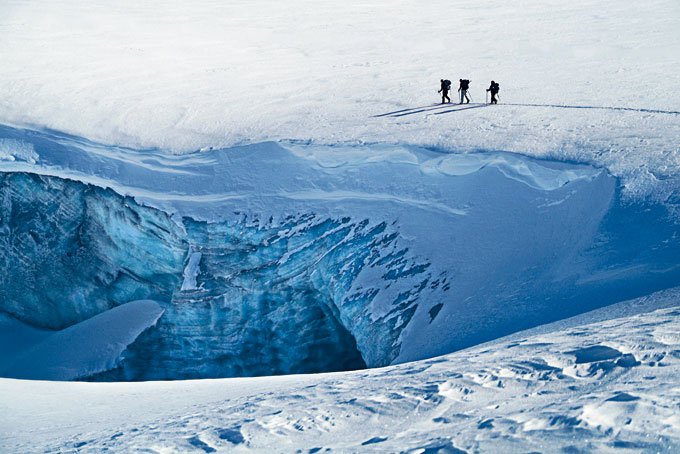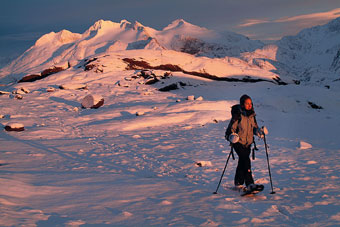

Kitting yourself out well in the mountains
Pleasures lie in the bag
From racing to major mountaineering, ranging from skiing to climbing, it isn’t always possible to transport equipment worthy of tackling all kinds of situations. As a result the common sense of the open air enthusiast is indispensable in the choice of clothing. A review of the particulars…
Text & photos : Romain Tornay
Prior to setting off on an outing, it is fundamental that you meticulously consult a precise weather report, which takes into account the duration of the escapade, the distances involved as well as the possibilities of shelter in the event of bad weather. In addition, a major issue characterizes mountainous areas: the higher the altitude, the harsher and more contrasted the changes in weather. Whatever the season, the weather can change very rapidly. In the middle-range mountains and in summer it is possible to go from blazing sunshine to bitter snow in less than an hour. As a result it is imperative that you kit yourself out appropriately to the environment in which the leisure activity is being practiced.
First of all, appropriate clothing is a guarantee of comfort, and hence pleasure. However, it also often enables you to avoid certain catastrophes. Though frostbite can be a problem at times, this is relatively rare apart from in extreme conditions. On the other hand, our body can quickly reach a state of hypothermia at any time of year, even at low altitude. In order to avoid this potentially fatal situation, we have to protect ourselves against three factors in the mountains: the cold, the damp and the wind.
Protecting yourself against the cold
The air doesn’t make us cold. It is our own organisms which attempt to heat the surrounding air, if the temperature of this is lower than the temperature of the body.
As a result it is necessary to insulate yourself as best you can from the atmosphere which surrounds you, in order to conserve the heat produced by your body. If we can’t supply the necessary energy to warm up the air, we cool down until there is a balance in the temperatures between the air and our bodies.
Wool constitutes a very good insulator. Nevertheless, woollen clothing is bulky (in a bag, for example), heavy and slow to dry. As a result it is preferable to equip yourself with trousers or a jacket of ‘woollen fleece’ whose heat balance is proportional to the thickness of the designs. Clothing made of ‘woollen fleece’ is compressible, light, permeable to perspiration and dries quickly. Wool should nevertheless be retained as the ideal material for protecting our feet and hands against the cold.
Underwear also plays a prominent role in retaining our heat. An initial layer (even fine) protecting both the lower and upper body will certainly keep us warm. In this instance, a material which is permeable to perspiration and dries rapidly is also preferable.
The best way to correlate our activity with the weather conditions consists of wearing several layers of clothing and removing them and adding them according to the effort involved and the temperatures. Underwear, a thin ‘woollen fleece’ as well as a second thicker layer may well represent a standard pattern in adapting our bodies to the majority of activities exercised by novice or amateur mountaineers. For those who are the most sensitive to cold or the most daring, an extra quilted layer provides optimal protection against the cold.
In addition, the loss of heat from our body isn’t proportional to the surface exposed. Certain parts, like the head, should be well protected. This is why it is highly recommended that you wear a hat and small gloves, even during the hottest months.
Protecting yourself against the damp
Dampness can result from two different sources. Though it would appear obvious that the rain, snow or fog are characteristic of dampness, you mustn’t neglect to protect yourself against perspiration. Our body must produce a lot more energy to heat the water than the air to the same temperature. As a result, when we’re damp, we cool down a lot quicker.
The ‘woollen fleece’ mentioned above provides no protection against dampness, so it is imperative to add a final layer to your equipment. It is advisable to use a jacket and fairly thin trousers, equipped with a material which is both breathable and waterproof. The majority of components manufacturers call upon the infamous Gore Tex® fabrics to ensure this characteristic.
Stay dry! Such could be the motto of the mountaineer. Therefore it is essential to add a change of clothes to your clothing bag to replace the layers which cannot be dried rapidly.
Protecting yourself against the wind
The wind takes away the thin layer of air heated by our body beforehand, which must begin its job all over again as a result. The ‘cold’ feeling is then increased. For example, according to the chill factor, a temperature of 0°C endured in a 40 km/hr wind is equivalent to a temperature of –16°C. Generally, if a material is waterproof in the rain, it also insulates against the wind. However, the reverse is not true. Certain components manufacturers provide clothing made of ‘woollen fleece’ which is equipped with a layer which protects against the wind. In the end, this clothing only partially protects against the wind, and is ineffective against the rain or the snow. For maximum protection, we once again make reference to the infamous materials produced by Gore Tex®.
Read the rest of the article in the Mountain Report magazine - Where to find ?


